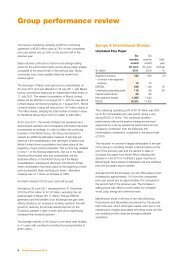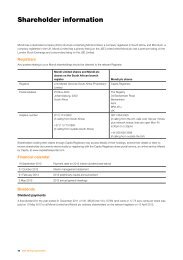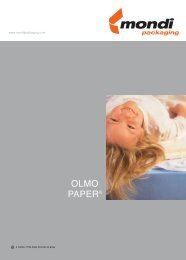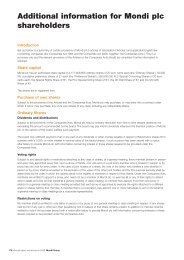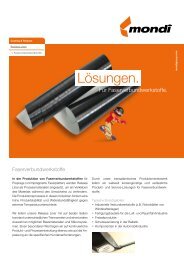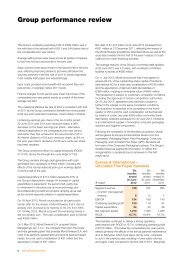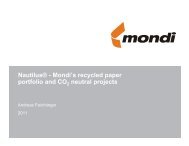Financial statements - Mondi
Financial statements - Mondi
Financial statements - Mondi
You also want an ePaper? Increase the reach of your titles
YUMPU automatically turns print PDFs into web optimized ePapers that Google loves.
1 Accounting policies (continued)<br />
Translation of overseas operations<br />
The Group’s results are presented in euros (the Group’s functional and presentation currency), the currency in which most of its<br />
business is conducted. On consolidation, the assets and liabilities of the Group’s overseas operations are translated into the<br />
presentation currency of the Group at exchange rates prevailing on the reporting date. Income and expense items are translated<br />
at the average exchange rates for the year where these approximate the rates at the dates of transactions. Exchange differences<br />
arising, if any, are recognised directly in other comprehensive income, and accumulated in equity. Such translation differences are<br />
reclassified to profit or loss only on disposal or partial disposal of the overseas operation.<br />
Share-based payments<br />
The Group operates a number of equity-settled, share-based compensation schemes. The fair value of the employee services<br />
received in exchange for the grant of share awards is recognised concurrently as an expense and an adjustment to equity. The<br />
total amount to be expensed over the vesting period is determined by reference to the fair value of the share awards granted, as<br />
adjusted for market performance conditions and non-vesting conditions where applicable. Vesting conditions are included in<br />
assumptions about the number of awards that are expected to vest. At each reporting date, the Group revises its estimates of the<br />
number of share awards that are expected to vest. It recognises the impact of the revision to original estimates, if any, in the<br />
combined and consolidated income statement, with a corresponding adjustment to equity.<br />
<strong>Financial</strong> instruments<br />
<strong>Financial</strong> assets and financial liabilities are recognised in the Group’s combined and consolidated statement of financial position<br />
when the Group becomes party to the contractual provisions of the instrument.<br />
<strong>Financial</strong> asset investments<br />
Investments, other than investments in subsidiaries, joint ventures and associates, are either classified as available-for-sale or loans<br />
and receivables.<br />
Available-for-sale investments are initially recorded at fair value. They are subsequently remeasured at each reporting date to fair<br />
value. Any unrealised gains and losses are recognised in other comprehensive income and deferred in equity until an investment is<br />
disposed of or impaired, at which time the cumulative gain or loss deferred in equity is included in the combined and consolidated<br />
income statement.<br />
Loans and receivables are measured at initial recognition at fair value, and are subsequently measured at amortised cost using the<br />
effective interest rate method.<br />
Cash and cash equivalents<br />
Cash and cash equivalents comprise cash on hand and demand deposits, together with short-term, highly liquid investments of a<br />
maturity of three months or less from the date of acquisition that are readily convertible to a known amount of cash and that are<br />
subject to an insignificant risk of changes in value. Bank overdrafts are shown within short-term borrowings in current liabilities on<br />
the combined and consolidated statement of financial position. Cash and cash equivalents in the combined and consolidated<br />
statement of cash flows and in the presentation of net debt are reflected net of overdrafts.<br />
Trade receivables<br />
Trade receivables are initially recognised at fair value and are subsequently carried at amortised cost using the effective interest rate<br />
method, less allowance for any impairment as appropriate.<br />
Trade payables<br />
Trade payables are initially recognised at fair value and are subsequently carried at amortised cost using the effective interest rate<br />
method.<br />
Borrowings<br />
Interest bearing loans and overdrafts are initially recognised at fair value, net of direct transaction costs. Borrowings are<br />
subsequently measured at amortised cost. Any difference between the proceeds, net of transaction costs, and the redemption<br />
value is recognised in the combined and consolidated income statement over the term of the borrowings using the effective<br />
interest rate method.<br />
<strong>Mondi</strong> Group 85<br />
<strong>Financial</strong> <strong>statements</strong>



